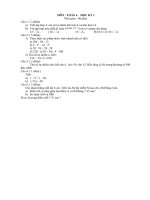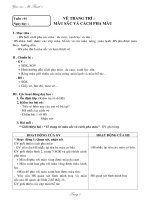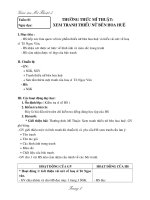Tài liệu WHY - WHY ANALYSIS TRAINING doc
Bạn đang xem bản rút gọn của tài liệu. Xem và tải ngay bản đầy đủ của tài liệu tại đây (312.93 KB, 66 trang )
WHY - WHY ANALYSIS
TRAINING
☯
OBJECTIVES:
☯
To understand the definition of Why - Why Analysis.
☯
To clarify the procedure for developing a Why - Why
Analysis.
☯
To stress the importance of each step in the Why -
Why Analysis.
☯
COURSE SCOPE / JUSTIFICATION:
☯
Why-Why Analysis is a basic, fundamental tool in the
development of the IWS cornerstones, so it is essential
that each Leader in the implementation of IWS know
this technique and transmit it to his/her work teams.
WHY - WHY ANALYSIS
☯
What is Why-Why Analysis?
☯
It is a tool to identify root causes of a problem
so that countermeasures can be applied to
prevent reoccurence.
☯
Why-Why Process:
☯
Basically the process is to keep asking why
for all possible causes until you can find the
root cause for each effect and, therefore, find
a countermeasure for each root cause.
Why-Why Analysis
☯
A different way to organize Cause and
effect relationships.
☯
More efficient after a Cause and effect
Analysis
☯
Done on the Priority items found in a
Cause and Effect Analysis.
How do tools fit?
Effect
HuMan Machine
MethodsMaterial EnvironMent
Cause Effect
Type of Check
Check Details
1. Direct Observation
2. Evidence from collected data
3. Expert’s experience
4. Theory
5. Others
Thesis
Already existing reference standard
Check method to be
used
Already existing Control Method
Results of the check
Verify existence of cause
and effect for this situation
Cause and Effect Worksheet
Problem Why Why Why Why Why
☯
Go On the Floor, at the point of the problem
☯
See the problem
☯
Listen to the people who live the problem
Recommneded Why-Why
Analysis Approach
What is the Product of a Why-Why Analysis ?
It is a structured, field checked, relationship with each
cause-effect relationship linked from the lowest
element back
to the
phenomenon.
P
h
e
n
o
m
e
n
o
n
W
h
y
?
W
h
y
?
W
h
y
?
W
h
y
?
Why?
R
o
o
t
C
a
u
s
e
Std.’
s
E
x
i
s
t
?
A
c
t
i
o
n
T
a
k
e
n
?
A
c
t
i
o
n
Standards
(4M’s)
h
u
M
a
n
e
q
u
i
p
M
M
e
t
h
o
d
M
a
t
e
r
i
a
l
SOP
E
x
i
s
t
?
True
NTru
e
X
X
X
A
p
p
l
i
e
d
?
F
i
e
l
d
C
h
e
c
k
Y
N
Y
N
Restore
New
Std.
New
Maint.
Std.
Y
N
WHY-WHY
NTru
e
Let’s Break the Analysis
into the Following Steps
1. Understanding the Problem
2. Defining the Phenomenon to be analyzed.
3. Establishing Cause-Effect Relationship
through Why questioning and Field Checks.
4. Logical Review of the Analysis
5. Checking for Standards and SOP’s
Let’s See What’s going on?
1. The light bulb
“doesn’t go on”
2. “He slipped”
3. The match
“doesn’t light”
4. The pen
“doesn’t
write”
Time: 10’
1. Understanding the Problem
Understanding the problem
•
Form a team of qualified,
knowledgeable people.
•
Develop a general description of the
problem.
•
Develop an initial problem statement.
How you focus on the
Problem Greatly impacts the
success of the Analysis.
1. Understanding the Problem
a) According to the Process or Work Flow requirements.
b) According to the physical causes.
Two Clarifying approaches
1. Understanding the Problem
Identify those conditions required by the
Process to correctly operate and check all of
them before start doing the analysis.
(Checklist)
Advantages:
+Simpler
+More practical
+Faster
According to Process or Work Flow requirements
1. Understanding the Problem
Identify the mechanics that generates the
phenomenon and start the analysis based on it.
Advantages:
+More complete
+More precise
+More effective
This material considers this
approach as the standard way to
perform why-why analysis.
According to physical causes.
1. Understanding the Problem
☯
Define the the Phenomenon
☯
We intend to define the mechanics that
generate the phenomenon, in other words, the
way or process through which what we are
describing occurs.
☯
Break the problem down into specific,
observable phenomena.
☯
Align the team on what success looks like.
2. Defining the Phenomenon to be analyzed.
General Problem vs
Phenomenon
☯
General Problem
☯
An intricate, unsettled question or issue
☯
A source of perplexity or distress
☯
Made up of many observable
phenomenon
☯
Phenomena
☯
Specific, observable facts or events
Problem vs Phenomenon Example
Problem: The room is too dark
Better: The light bulb “doesn’t go on”
Best: There is no flow of electric current through
the filament
Problem vs Phenomenon Examples
Examples Problems
?
Phenomena?
Process reliability is below 90%
The heat exchanger plates are cracked
The reactor pump seals leak
Product quality deviations are excessive
Bottle product labels are scratched
Bottle are being underfilled by 2 ounces per bottle
The family car is worn out
The engine is using one quart of oil every 500 miles
The car seats are ripped
Scotoma Training
☯
Definition
☯
Scotoma literally means “limited vision within our
field of vision.” It is used to explain the fact that we
sometimes see what we expect to see.
☯
How it links to this training
☯
Scotomas can keep us from recognizing the
causes to some problems. We might not even
recognize the problem. (Like the way we overlook
defects if we have gotten to the point where we
consider them as normal.)
What’s the problem?
What’s the problem?
What’s the problem?
What’s the problem?
What’s the problem?
What does Success Look Like?









